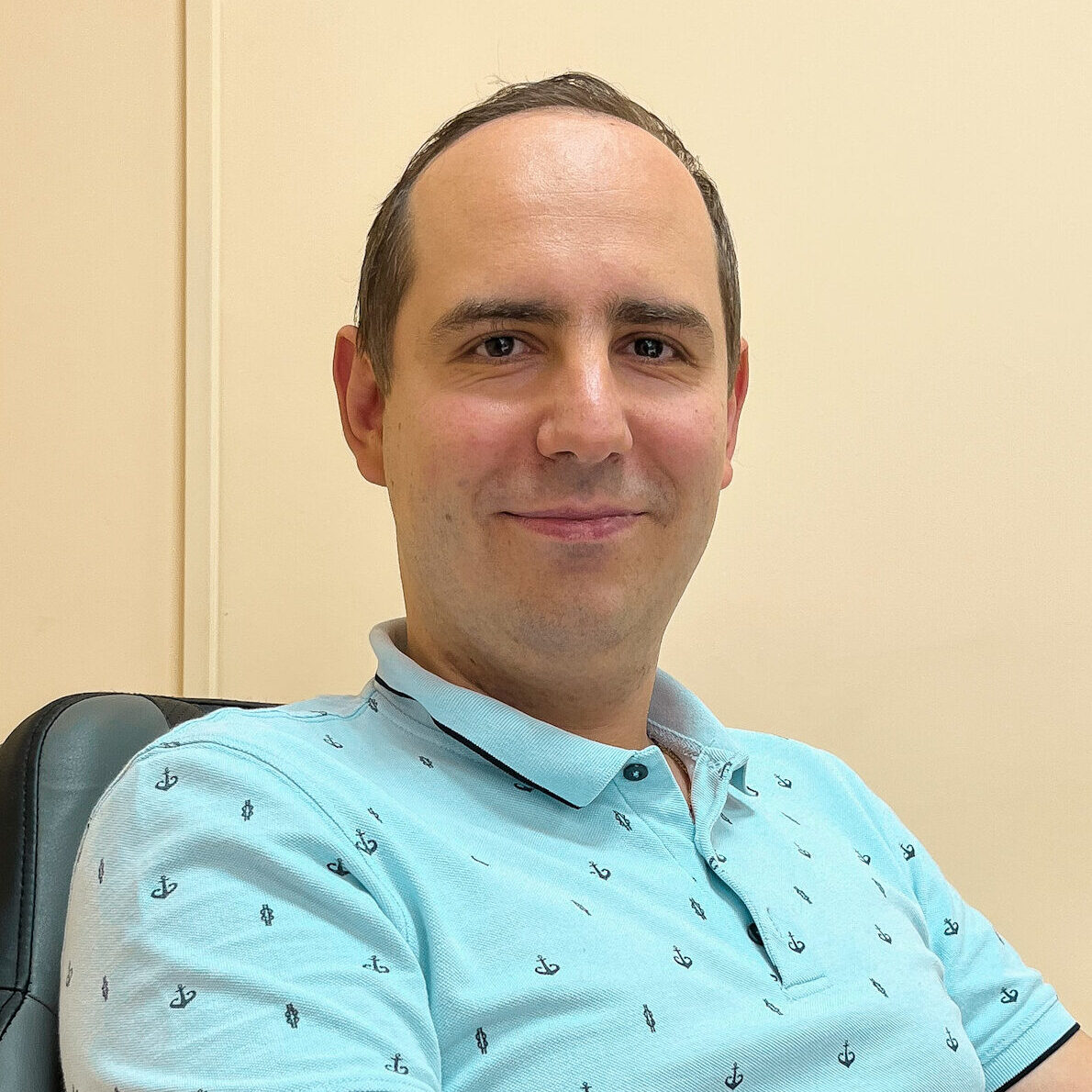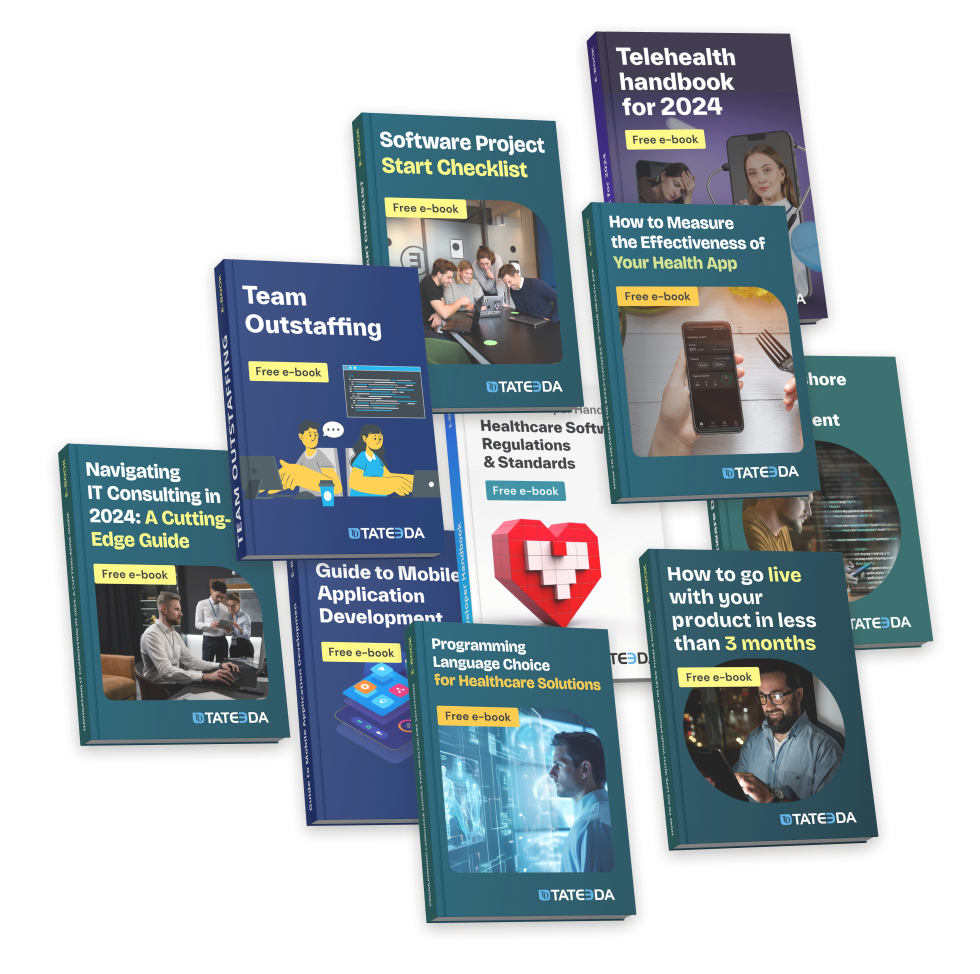IoT in Healthcare: Benefits, Challenges and Solutions

In this post, we’ll discuss how the IoMT (a.k.a. connected health systems) can benefit medical providers, healthcare facilities, and organizations, both in the U.S. and worldwide. This includes a dedicated algorithm for building IoT healthcare solutions.
Over the past decade, healthcare technology has taken a quantum leap, providing new tools to hospitals, clinics, and practitioners to improve the quality of patient care while streamlining the processes associated with the business end of the industry. Internet of Things (IoT) technology connects healthcare devices to one another in order to integrate and document every step of the patient journey, from initial consultation to release. Another name for this technology is IoMT (Internet of Medical Things), or connected health systems.
| Who are we? TATEEDA GLOBAL is a California-based company that offers everything required to create custom HIPAA-compliant IoMT software solutions for hospitals, health-tech businesses, and healthcare startups. We have skilled healthcare software engineers that can help you with the… ✔️ EHR & EMR software development ✔️ Dedicated .NET development ✔️ Telemedicine solution development ✔️ Biotech software development ✔️ DevOps development services If you need immediate technical advice from our seasoned healthcare IoT expert, please contact us to schedule a free chat and get a project estimate: ? |

Slava Khristich
Healthtech CTO
Based in San Diego, Slava knows how to design an efficient software solution for healthcare, including IoT, Cloud, and embedded systems.
Table of Contents
Technically, What Is IoMT?
A typical IoMT solution consists of a few major layers. At the front edge, the IoMT environment includes a group of medical devices and applications that are interconnected via local computer networks, Wi-Fi, and/or other networking technologies in order to exchange information and maintain stable machine-to-machine communication.
At the back end of the Internet of Things in healthcare, local groups can be connected to a cloud platform (such as AWS) to accumulate, analyze, and mine health data coming from a variety of field operations. This takes place in such a way that multiple smaller groups can be incorporated via intermediary hubs into complex hierarchical IoT healthcare networks with a powerful AI-driven component at the top of the system.
It has been projected that the IoMT market will reach $72.02 billion in 2021. According to Deloitte, it will hit the $158 billion mark by 2022. At the same time, the number of active IoMT devices will increase as much as $20-30 billion! These are very promising numbers indicative of the ever-growing demand for IoMT services. Moreover, North America is projected to become the biggest market, thanks to accelerated interest in healthcare IoT solutions (in particular due to the COVID-19 pandemic) as well as well-developed IT infrastructure in the region.
In this post, we’ll discuss how the IoMT (connected health systems) can benefit medical providers, healthcare facilities, and organizations, both in the U.S. and worldwide.

Learn more: ➡️ Medical Device Software Development Guide
Sectors of IoT Technology in Healthcare
Smart healthcare holds promise for patients and practitioners alike. Learn more here about the hottest health tech trends of the year. It eliminates multiple antiquated business processes and operations while facilitating improved patient-doctor relationships.
In fact, specific segments of IoMT solutions are working toward a range of purposes. In general, we can categorize them as on-body solutions (personal wearables), in-home systems, and in-hospital environments. All of these can be interconnected and function in a range of combinations and configurations.
Here are just a few of the many ways that the Internet of Things benefits healthcare:
Personal Wearable Devices in Healthcare
There is huge, ever-growing diversity in terms of wearable devices within healthcare, from simple consumer-grade devices for everyday use to sophisticated clinical-grade offerings intended to help people with diagnosed conditions. The IoMT setting for wearables is simple: in most cases, it’s enough to synchronize them with your smartphone or tablet to view and manage your health and/or exercise analytics within specific applications.
Health wearables for consumers include non-professional (consumer-grade) personal devices for sports, fitness, and wellness. These products don’t need special certification and can encompass different types of wearable devices used to measure and improve physical activity, productivity, sleep, social interaction, stress levels, and more. Basic products within this class are activity trackers, wristbands, sports watches, smart garments, and other tools. Some of these devices offer pretty advanced semi-professional functionalities and/or sensors, such as inbuilt oximeters to measure your heart rate, electromyographic sensors that measure your muscle activity, and electrodermal sensors to help control stress levels. All of these can be embedded in clothes, rings, wristbands, etc.
Clinical-grade wearables (like smart implants) are devices that require industrial certification and should be approved for use by the appropriate health authorities: for example the FDA in the U.S. This class of wearables is used to assist people with defined diagnoses in coping with their symptoms and/or preventing acute conditions. Devices like these require a medical prescription and physician’s instructions for usage. Examples include portable automated medication-injecting pumps (such as insulin or heart attack treatment medications); neuromodulation devices to alleviate chronic pain, seizures, or insomnia; blood-pressure management devices; ECG monitors; biosensors; and myriad other devices that are directly involved in patient health monitoring processes and capable of saving lives with timely application (e.g., injections) or emergency alerts.
Read also: ➡️ Patient Electronic Data Capture Solution Development
The In-Home Segment of IoMT
A more complex category of IoMT solutions is simultaneously being deployed in patient homes. It involves specific configurations of Internet of Things healthcare devices, including certain types of wearables like smart sensors. Examples of these types of solutions include remote patient monitoring (RPM), personal emergency response systems (PERS), and telehealth systems.
Telehealth: One profound effect of the recent COVID-19 lockdowns was a surge in remote healthcare. Practitioners who had never before considered the concept were quick to find resources for conducting patient visits via telehealth. The benefits for patients have been enormous: protecting them from infection, saving time and energy, and providing a convenient way to meet with physicians. As an example of modern telehealth solutions, we can name medical second-opinion telemedicine platforms for patients seeking alternative medical conclusions.
Remote monitoring: Medical sensors and wearable devices make it possible for patients and their healthcare providers to monitor vital statistics like heart rate and blood pressure, keep an eye on blood sugar and insulin levels, calibrate pacemakers, and provide a broad range of other services that once required a trip to the clinic. Health monitoring via device will prove to be a game-changer for the elderly and disabled, who traditionally find it difficult to travel to medical appointments.
Personal emergency response systems: A PERS is intended to enable seniors and disabled or limited-mobility people living alone to get emergency medical help. If someone living under these circumstances needs to call for help, they can do so by pushing a button. A typical PERS integrates a lightweight battery-powered radio transmitter, a console connected to the person’s telephone, and an emergency response center that processes the calls. Modern PERS solutions can involve web cameras, smart sensors, and other devices.
| Are you interested in creating a medical IoT system for your practice? We can definitely help you… ☑️ Design and build custom IoT applications ☑️ Assist you in medical or biotech device-embedded programming ☑️ Healthcare IoT consulting and engineering ☑️ Provide more services in the context of the Internet of Medical Things. Please learn more about our healthcare software service capabilities, including team augmentation: |
Custom Healthcare Solutions
See how we can engineer healthcare software, validate your ideas, and manage project costs for you.
The In-Clinic and In-Hospital IoMT Sector
This is the largest and most sophisticated group of IoT healthcare solutions. Clinical or hospital IoT environments include a variety of professional-grade application options involving wearables, biosensors, software systems, robot cleaners, and even robot surgeons.
Surgical robotics: Intricate surgeries get a boost from IoT technology, which enhances the surgeon’s vision, control, and precision while ensuring better outcomes for surgical patients.
Electronic healthcare records (EHR): The IoT makes it possible for patients and practitioners to access and share real-time medical data, thanks to a connected, centralized record-keeping system. Data can be shared quickly and easily with labs, specialists, nurses, and/or other individuals involved in the patient’s healthcare sphere, thanks to custom EHR & EMR software development with a wide range of additional capabilities and modules.
Hospital Information Management System (HIMS): Large medical systems handle an enormous amount of data on a daily basis. This can involve mounds of paperwork. The IoT enables HIMSs to go paperless, dramatically reducing costs and manpower while boosting efficiency and accuracy.
Smart health insurance: Data captured by monitoring devices can help insurance companies make more informed decisions about pricing, risk assessment, claims, and underwriting, thereby increasing accuracy and reducing incidences of fraud. These capabilities can be included in a custom health insurance application.

Read also: ➡️ HL7 Integration: How to Build Interoperability Interface for Your Healthcare Systems
Internet of Things Benefits for Healthcare
Though the potential advantages of IoT are tremendous, one of the biggest challenges of ubiquitous IoT implementation in healthcare is getting people to embrace this technology. The whole idea is to simplify people’s lives by letting technology do the heavy lifting. However, technology still has a long way to go, and it is often the case that technological devices create more problems than they solve. For many individuals, the learning curve and complexity of technology make them reluctant to use it.
Internet of People
The Internet of People (IoP) advocates for user-friendly, people-centric technology that is easy to adopt and does not create stress or friction. The four fundamental tenets of IoP are as follows:
- Recognize social needs. Humans are social creatures, and we interact better with technology when it supports our social tendencies.
- Personalization is paramount. Technology should be customizable to reflect the sociological contexts and profiles of individual users.
- Make the IoT proactive. Rather than relying upon remote interfaces to manage connected devices, users should be able to adjust their preferences and define how proactively their devices should perform.
- Make IoT interactions predictable. Users should be able to depend on consistent, predictable behaviors from connected devices in response to specific prompts and actions. They should be informed of what information they are sharing and who will have access to it, and be able to set their own privacy preferences.
At the end of the day, healthcare is a people’s business, and technology should serve the people who use it, not the other way around. Medical IoT developers should consider IoP when building technology that will be used and relied upon by humans.
How Smart Medical IoT Devices Save Lives
Smart medicine relies upon IoT technology to increase accuracy and reduce the incidence and risk of life-threatening human error. Increasingly, the IoT is playing a vital role in managing patient conditions and performing life-saving functions. In many cases, sensors and monitoring devices interact with the patient’s smartphone to ensure real-time delivery of vital information to healthcare providers.
- Medical alerts: Wearable medical IoT devices are able to detect and report life-threatening episodes such as diabetic comas, seizures, and heart attacks. Some new sensors can even detect cancer.
- Smart pill bottles: Patient compliance when taking medication is a common problem in healthcare. Smart pill bottles alert patients when it is time to take their medicine, sending data to the cloud that timestamps when the bottle was opened and how much medication was removed (these capabilities can be delivered as a part of custom medication tracker app functionality.)
- Monitoring devices: Wearable technology allows for the remote monitoring of vital signs, physical activity, body temperature, sleep patterns, and other data to help manage the care of patients with chronic medical conditions.
- IoT for first responders: Heat/smoke sensors and personal tracking devices help protect firefighters from unsafe scenarios. Improved connected communication devices help first responders interact with one another in dangerous situations. IoT technology provides emergency medical services with lifesaving patient information during transport.
These are just a few examples of how medical IoT is transforming healthcare and impacting patient health. With the field still in its infancy, we can expect to see more innovations in healthcare IoT in the coming decade.
The Game-Changing Advantages of the IoMT
As you know, the IoMT is revolutionizing medical care, ushering in enhanced efficiency, better patient care, and reduced stress on healthcare providers and physicians.
Key outcomes of a full-scale IoMT implementation across U.S. healthcare facilities and organizations will include the following:
Reducing healthcare costs: The healthcare industry stands to benefit greatly from IoT technology, but the keystone advantage would be a continual decrease in healthcare costs. This will drive ongoing development of IoMT solutions, allowing more efficient use of healthcare resources. All of this has become especially critical during the COVID-19 pandemic.
Large-scale healthcare situation monitoring: Data captured by millions of medical IoT devices across the country will help authorities and scientists to build a rich multidimensional picture/hypothesis of pandemics and other widespread diseases while shaping policy and regulations in response. This research can be executed with the help of data analytics methods, including healthcare data visualization with charts showing epidemic/pandemic patterns, trends, and dynamics.
Preventive healthcare: The smart medicine of the future will leverage wearable devices to monitor at-risk and elderly patients as well as those with chronic diseases, looking for changes that could signal the onset of a worsening condition. For example, data indicating heart attack or stroke will be sent in real time to the cloud, where doctors can act quickly to intervene.
Enhanced patient experience and care: Adoption of IoT solutions minimizes wait time in hospitals, prevents errors, improves treatment outcomes, encourages cost-effectiveness in healthcare, and helps physicians to better manage nursing staff, diagnostic processes, and patient medical plans. IoT solutions can become a vital component of a virtual nurse application offering remote medical assistance and facilitating patient self-care format.
Delivered Healthcare Software Portfolio
The leading American healthcare companies benefit from working with us.
How to Implement an IoMT System in a Healthcare Facility
1. Make sure all IoT devices and gateways are properly protected. There exist hundreds or even thousands of different IoT edge devices:
- Remote thermometers
- Vital sign data-capturing sensors
- Blood-pressure sensors
- Air quality sensors
- Medication refill reminders (learn more: automated medication refills with the help of e-prescription solutions)
- Drug efficacy tracking tools (smart pills, smart pill bottles, etc.)
- Sleep monitors
- Biometric scanners
- Remote supervision tools for babies
- Asthma inhalers
- Automated medication injectors
- Smart heart meters
Despite their great diversity, many IoT devices share the same traits: they are simple, energy-efficient, and inexpensive enough that they can be deployed anywhere in high volumes.
In order to maintain affordable pricing and keep devices small, manufacturers limit their computational capacity to core tasks only. This means that medical IoT devices have no spare resources for running cyber protection applications, and data security tasks rely entirely upon higher levels of the network or local IT infrastructure. Because of this, no HIPAA violations are possible (data breaches, tampering, or loss) if anything gets hacked.
Addressing cybersecurity challenges in the use of IoT in healthcare may require deployment of a smart firewall to monitor the behavior of separate IoT devices and components and identify any abnormal activity patterns. A firewall would also cut off hacked devices and prevent interference with the rest of the system.
If you have ideas or projects related to IoMT integration and need professional help, consult with TATEEDA GLOBAL. We are a custom software development company specializing in healthcare solutions, including IoMT and cloud-based technologies: for example, the remote health-monitoring app that helped present ECG data to health care providers via iOS and Android tablets.
2. Make sure the devices involved in the IoMT system are as user-friendly as possible. When you build a consumer-grade or in-house IoMT solution involving patient/device interactions, make sure the device(s) are suitable for mass adoption, i.e., comprehensible and convenient.
IoMT devices should comply with the following requirements:
- Any learning curve or setup time should be eliminated. Medical devices must be all set by the time they reach the patient’s hands, without the need for additional configuration. Any personalization should be done beforehand by a qualified medical professional.
- The device and software system supporting your interface should be perfectly debugged, with no room for fatal errors or unpredicted use cases.
- The battery capacity should be the best available, allowing for maximum device lifespan without the need for recharging or replacement.
- Provide a simple, brief, comprehensive user manual and instructions if needed.
Read also: ➡️ How to Create Medical Staff Management and Scheduling Software
3. Make sure an optimal network design is in place. In IoMT projects, all sorts of network vulnerabilities might need to be addressed, and any weak links should be immediately identified and strengthened. Since IoT projects involve a wide range of components, one of the worst possible nightmares is an IoMT integration challenge. The term encompasses all of the potential issues you may need to overcome when fighting for better connectivity and interoperability between medical devices and networking layers.
Basically, the IoMT consists of the following layers, which should be smoothly integrated depending upon the healthcare IoT solution’s complexity and scale:
- Edge devices, including electronic tools and sensors collecting patients’ biometric data and the environmental conditions required by the system.
- Edge gateways working as network hubs and connecting edge devices to a cloud platform.
- Technical protocols for machine-to-machine (M2M) communication, including device-to-device (D2D), device-to-gateway, and gateway-to-data-system protocols.
- IoT platforms transmitting data from smart devices and hardware to the cloud. These are used to manage edge-layer devices.
- Cloud-based data analytics and asset-management systems, employed to convert the incoming flow of information into valuable insights.
Learn more: ➡️ How to Move to the Cloud for Healthcare Companies & Organizations
Some of the communication, network, and data protocols and technologies used in IoMT architecture include:
- MQTT (Message Queue Telemetry Transport)
- DDS (Data Distribution Service)
- AMQP (Advanced Message Queuing Protocol)
- Bluetooth
- ZigBee
- WiFi
- Cellular (4G/5G)
- LoRaWAN
- OSI model protocols
4. Make sure a team of experienced tech specialists is in place to integrate IoMT system components. Developing the Internet of Things in the context of healthcare is, inevitably, an intricate undertaking. Projects bring together multiple IT specialists, like front-end and back-end software developers, electronic device engineers, embedded systems engineers, data engineers, and more.
Read also: ➡️ How to Maintain and Improve Your Healthcare Software
If you need qualified help in developing an IoMT software system or application, hire TATEEDA GLOBAL. We have a full-cycle team of medical software engineers who can bring their expertise and resources to your IoT health tech project. We offer a variety of services, including staff augmentation, project reinforcement, and software system integrations involving IoT components and cloud platforms. Contact us today for a free consultation.
IoMT Challenges and Solutions
The stories coming out of innovative IoT technology are all very similar… especially when it comes to a sensitive industry like healthcare. There is always the tendency to create more new issues than solutions. Because IoT tech in the context of the healthcare industry still lacks maturity, many potential challenges need to be taken into account whenever you are implementing a connected health solution.
- Cybersecurity challenges inherent to IoT in healthcare. Compliance of IoMT systems with HIPAA requirements is one of the biggest concerns. All patient data is sent to the cloud or to local storage via network hardware and communications. This entire pathway is fraught with innumerable vulnerable points prone to data leaks, so a complex cybersecurity approach is necessary to cover all potential drawbacks and prevent data incidents.
- Cost of building IoMT systems: The per-implementation price tag of a medical IoT solution can vary from $10k-30k to unlimited, depending upon the complexity and scale of the connected health system. However, the price of IoT solutions (not only in healthcare) tends to be lower because of the high number of ready API-based/SaaS solutions and applications currently entering the IoT market. There is also a huge choice of edge devices available out there.
- Medical staff training. It’s necessary to educate medical personnel on the basics of interacting with IoMT applications and hardware. For example, putting certain biosensors on a patient’s body while working with IoT applications can require new skills, and this can entail additional costs or inefficiencies.
- Deploying IoT infrastructure. Acquiring, installing, and configuring the necessary hardware/software can prove tricky, and it can hardly be executed without the help of a qualified IT partner.
Examples of successful IoMT implementations:
- Inside hospitals and other healthcare facilities, robots can take care of multiple chores, freeing human staff members for more important tasks and thereby decreasing their exposure to contagious diseases. Important yet low-ranking chores, such as disinfection, delivery of medications and food to patient beds, vital-sign monitoring, and other tasks can be easily delegated to medical robot helpers.
- Glucose monitoring has always been a tedious task for patients who need to take blood tests frequently, then manually record the results to identify fluctuations in glucose levels. A compact, energy-efficient IoT solution helps them resolve these issues by offering a continuous glucose-monitoring system for patients. This type of device can automatically monitor glucose levels, alerting patients when this critical health indicator needs their attention.
- UAE authorities recently introduced the first virtual hospital in the Middle East. Here, healthcare professionals provide remote assistance to patients in their homes or at other locations with the help of smart monitors and IoT devices.
- Philips has already introduced wireless biosensors that collect, store, and transmit the heart and respiratory rates of COVID-19 patients and/or those with known exposure to the disease. Patients can then be cared for in isolation, allowing physicians to remotely monitor their health and prevent potential worsening of their condition.
Custom Medical IoT Software from TATEEDA GLOBAL
Healthcare IoT is the wave of the future, and your organization cannot afford to ignore it. TATEEDA GLOBAL develops customized HIPAA-compliant IoT solutions for the healthcare and biotech sectors to help you improve the quality of patient care and streamline your operational processes. Our services include:
- Custom medical software architecture and full-cycle development (web, mobile, desktop, cloud)
- Cloud development: Azure, AWS, Digital Ocean, Google
- Integrated health tech solutions featuring wearables, mobile, embedded programming, and a diverse array of IoT medical and/or biotech devices
- Tech consulting, staff augmentation, and project reinforcement services.
Contact Tateeda GLOBAL today to see how IoT technology can benefit your organization and patients.






